Search the Special Collections and Archives Portal
Search Results
Shirley Mudra oral history interview
Identifier
Abstract
Oral history interview with Shirley Mudra conducted by Barbara Tabach on November 30, 2011 for the Boyer Early Las Vegas Oral History Project. In this interview Shirley Mudra discusses life as the wife of a Nevada Test Site manager, family life in Las Vegas, Nevada, details of Las Vegas post 1966, and friendships in the city.
Archival Collection
Letter from Jona L. Souder, Chief, Local Public Document Room Branch, Division of Rules and Records, Office of Administration and Resources Management, United States Nuclear Regulatory Commission to Mary Dale Deacon, Director of Libraries, University of Nevada, Las Vegas confirming the establishment of the James. R. Dickinson Library, as the Nuclear Regulatory Commission's (NRC) official local public document room (LPDR) for material related to the licensing of the Department of Energy's proposed high-level waste geologic repository site near Yucca Mountain, Nevada with Federal Register Notice, 1988 February 17
Level of Description
Archival Collection
Collection Name: Yucca Mountain Site Characterization Office Collection
Box/Folder: Box 01
Archival Component
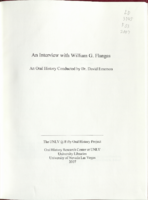
Transcript of interview with William G. Flangas by Dr. David Emerson, September 27, 2006
Date
Archival Collection
Description
Text
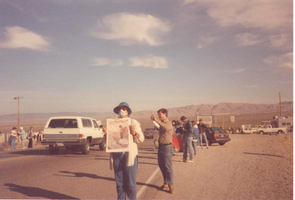
Protestors waving at cars entering the NTS: photographic print
Date
Archival Collection
Description
Image
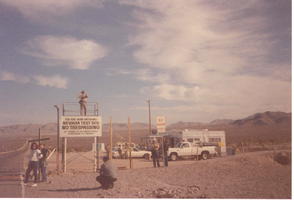
Protestors and police around no trespassing sign: photographic print
Date
Archival Collection
Description
Image
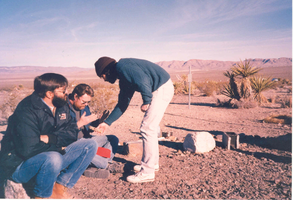
Three unidentified protestors on Ash Wednesday: photographic print
Date
Archival Collection
Description
Image
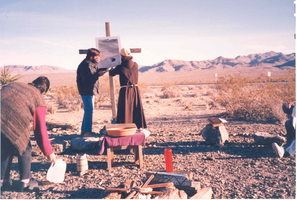
Three unidentified protestors preparing for Ash Wednesday: photographic print
Date
Archival Collection
Description
Image

Interview with Philip Wymer Allen, August 26, 2004
Date
Archival Collection
Description
Text

Transcript of interview with Mary Shaw by Barbara Tabach, September 2, 2011
Date
Archival Collection
Description
For the first 19 years of her life, Mary Martell Shaw called Central America home. Then thanks to misrouted luggage, she met the love of her life Rollin H. Shaw, a civil engineer, at a time in when his atomic energy career was taking off. In October 1943, they married in Costa Rica and for the next two decades traversed the country: Hawaii to California to Panama—wherever a project required Ronnie's engineering skills. Mary supported her husband every step of the way, with every new location. As a traditional homemaker of the era, she became adept at raising their four kids while packing boxes, enrolling them in school and setting up a warm home wherever they landed. The move to Las Vegas in September 1964, however, left her a bit challenged: there was a shortage of adequate housing, a concern for where to send her two daughters and two sons to school, and the feeling that they wouldn't be here long. Years later, Mary and Ronnie would retire to the city where their roots ran deepest, Las Vegas. With great wit, Mary recalls the long absences demanded by Ronnie's work with the Atomic Energy Commission. She also tells stories of the great fun they and their fellow Nevada Test Site employees had at parties, of her learning to paint with watercolors, and the pride she has of all her children's successes based on their education in Las Vegas.
Text
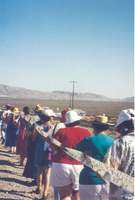
Protestors form a line while holding ribbon: photographic print
Date
Archival Collection
Description
Image
